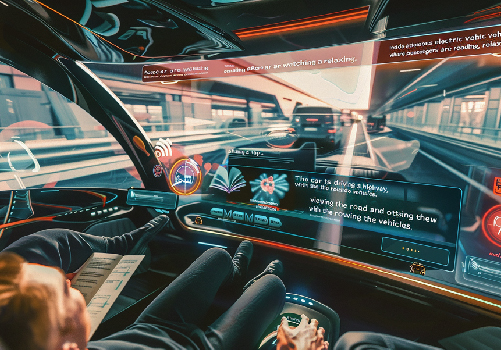
The trucking industry faces a growing shortage of qualified drivers, making recruitment and training a top priority for companies. One innovative solution gaining traction is the use of driving simulators. These simulators are transforming the way trucking companies attract and train new talent, especially among the younger generation. While simulators can’t fully replicate real-world driving, they provide a controlled and safe environment for honing essential driving skills. As the technology evolves, it’s proving to be a valuable asset for companies looking to bridge the gap between classroom learning and on-road experience.
Enhancing Driver Training with Advanced Simulators
For many Commercial Driver’s License (CDL) trainers and fleets, truck driving simulators are an ideal tool for training both novice and experienced drivers. Equipped with high-definition graphics and immersive sound systems, simulators replicate a wide variety of driving scenarios, such as navigating through heavy traffic, managing high winds, or dealing with icy roads. This versatility allows trainers to assess a driver’s skills and identify areas for improvement without the risks associated with on-the-road training.
According to Russell Hoyt, director and co-founder of MG Truck Driving School in Glendale, Arizona, simulators help drivers master the fundamentals of truck operation. “When we get a driver trained on a simulator, they really understand the basics and fundamentals of driving a truck,” said Hoyt. His enthusiasm for the technology led him to develop simulators that simulate real-time scenarios like jackknifing—a dangerous condition in which the trailer swings out of control. While these scenarios are impossible to practice safely on real roads, simulators offer a realistic environment to practice maneuvers such as controlled braking and emergency handling.
Boosting Recruitment and Outreach Efforts
The Nebraska Trucking Association has taken simulator training a step further by using it for outreach and recruitment. Kent Grisham, president and CEO, explained that their mobile simulator, housed in a cargo trailer, is primarily used for workforce development. It targets younger audiences by showcasing career opportunities in trucking, safety measures, and the advancements in trucking technology.
Community colleges across Nebraska have also adopted simulator technology to give students practical experience between classroom sessions and on-road training. “It’s better to practice driving on icy roads in a simulator than to take them out in a blizzard,” Grisham emphasized. This approach ensures that new drivers are better prepared to handle real-world conditions safely.
Innovative Use of Simulators by Major Fleets
Larger companies like UPS have integrated simulators into their driver training programs on a national scale. In 2020, UPS launched a series of simulators housed within its training facilities and mobile units. These simulators, developed in-house, are installed in actual UPS package cars, providing a highly realistic environment for driver training. “We’re able to display 360-degree video experiences developed from real roadways,” said Tristan Christensen, UPS’ content development director for U.S. Operations Training. By simulating high-risk scenarios, such as navigating intersections with distracted pedestrians or dealing with inclement weather, UPS ensures its drivers are equipped to handle the most challenging situations.
Evaluating Driver Skills with In-House Simulators
Smaller carriers are also finding creative ways to use simulators. Fremont Contract Carriers in Fremont, Nebraska, purchased an in-house simulator at auction, which they now use to evaluate and train newly licensed drivers. Historically, the company only hired drivers with at least two years of experience. But the simulator has allowed them to develop a training program for less experienced drivers, thus widening their recruiting pool.
The simulator serves as an initial assessment tool to gauge a driver’s skills. “We thought, ‘Why don’t we assess their skills instead of passing on them?’” said Tim McCormick, president and CEO. The company can now put new drivers through scenarios that replicate poor weather conditions or emergency situations to determine their skill level before they hit the road. This approach not only helps them identify promising new drivers but also ensures the safety of everyone on the road.
Challenges to Widespread Adoption
Despite their benefits, simulators are not yet a standard part of driver training programs. One reason is the cost. Full-scale simulators are a significant investment, often only accessible to larger carriers or training schools. Mobile simulators, like the one used by the Nebraska Trucking Association, provide a more affordable option for smaller companies that want to take advantage of this technology. “Portable units have become more mainstream because they are more affordable,” said McCormick. Additionally, space constraints and an “old-school” mentality within the industry have slowed the adoption of simulators.
There’s also the misconception that simulators are more like video games than training tools. However, the data speaks for itself. According to Hoyt, accident rates drop by up to 80% for drivers who have undergone simulator training compared to those who haven’t. This makes a compelling case for simulators as an effective method of reducing accidents and operational costs.
Return on Investment and Future Potential
The return on investment (ROI) for simulators goes beyond immediate cost savings. The benefits are also seen in long-term safety improvements, reduced accident rates, and lower equipment damage. “If you had two average drivers with the same ability, one trained on a simulator and one not, I guarantee you the one trained on it will be 10 times the driver,” said Hoyt. This advantage extends to skill retention and better fuel efficiency, as drivers who train on simulators are less likely to develop costly habits like over-revving or excessive idling.
For companies like UPS, the investment has already shown promise. Since introducing simulators, UPS has seen a 20% improvement in graduation rates and on-road performance scores. Increased interest from part-time workers considering obtaining their licenses is another positive outcome.
The Future of Simulator Technology in Trucking
As simulator technology advances, incorporating artificial intelligence (AI) and virtual reality (VR) could make the experience even more lifelike. Hoyt envisions a future where drivers can look out simulated windows, interact with virtual controls, and experience increasingly realistic driving conditions. As costs decrease and technology improves, simulators may become a standard component of CDL training programs nationwide.
Conclusion
Driving simulators have become a powerful tool in reshaping how trucking companies recruit and train new drivers. They offer a unique blend of safety, realism, and versatility that appeals to both younger drivers entering the industry and experienced drivers looking to refine their skills. By allowing trucking companies to simulate challenging driving scenarios, reduce accident rates, and identify the best candidates, simulators are proving to be a smart investment for the future of driver training. As more companies recognize the benefits and technology continues to advance, the use of simulators will likely become a standard part of the recruitment and training process in the trucking industry.
TMS-Digital is one of the leading providers of Transportation Management System (TMS) software in the U.S. trucking industry. With a commitment to innovation and efficiency, TMS-Dispatch by TMS-Digital offers a comprehensive suite of tools designed to streamline fleet management, optimize routes, and improve overall operational efficiency. Their solutions are trusted by carriers and logistics companies nationwide, helping them stay competitive in a rapidly changing market. By integrating state-of-the-art technologies such as real-time tracking, analytics, and now advanced driver training tools, TMS-Digital continues to set the standard for excellence in transportation management.
Are you ready to take your trucking operations to the next level? Discover how TMS-Digital can transform your business with its cutting-edge TMS solutions and advanced training tools. Visit TMS-Digital today to learn more and schedule a demo with one of our experts!










